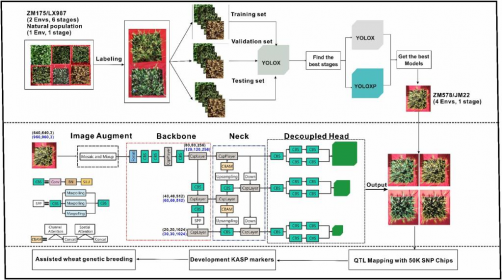Science
New AI Model Enhances Wheat Spike Counting Accuracy to Over 95%

A recent study has developed an advanced deep learning model that significantly enhances the accuracy of counting wheat spikes, achieving precision levels above 95%. Conducted by researchers from the Chinese Academy of Agricultural Sciences (CAAS), the study employs an improved YOLOX-P model and optimizes growth-stage selection to link phenotypic data with genetic markers, providing breeders with a powerful tool for high-throughput phenotyping.
As global populations rise and diets evolve, wheat production must increase by at least 60% by 2050. Wheat serves as a fundamental source of carbohydrates, protein, and dietary fiber for billions around the world. Traditional breeding efforts have primarily focused on enhancing kernel size and number, but advancements in increasing spike number—a crucial yet complex trait—have been limited. The slow and subjective nature of manual spike counting has proven impractical for larger trials, necessitating a shift toward automated solutions.
The researchers addressed these challenges by utilizing next-generation algorithms to refine spike counting methods. Their findings, published in the journal Plant Phenomics on May 13, 2025, detail how they developed and tested spike number detection models using images collected across six developmental stages of the Zhongmai 175 × Lunxuan 987 recombinant inbred line (RIL) population. The models were further validated in additional populations, demonstrating their broad applicability.
Ten models were trained and evaluated using four key performance indices: precision, recall, mean average precision (mAP), and F1 score. Results showed consistently high precision rates ranging from 88.19% to 95.48%, indicating reliable spike identification. However, recall rates varied significantly, between 44.60% and 81.23%. Notably, the late grain-filling (LGF) stage yielded the best performance, achieving the highest recall of 81.23% and mAP values between 85.69% and 89.47%.
In comparing manual counts to model counts, known as labeled spike numbers (ISN), the team found that the quality of annotations strongly influenced accuracy. The smallest discrepancies occurred during the LGF stage, where strong correlations (r = 0.84 to 0.88) were observed between manual and model counts across various environments.
In their efforts to enhance detection further, the team developed an improved YOLOX-P algorithm by integrating attention modules and utilizing higher-resolution input images. This modification led to a significant performance boost, with an increase in mAP by 5.30% to 5.99% and a rise in F1 scores by 0.06 compared to the original YOLOX model. Among integrated datasets, the CD&DD subset trained with YOLOX-P achieved the highest mAP of 91.81%.
Validation in the Zhongmai 578 × Jimai 22 population further confirmed the robustness of these models, showing correlation coefficients between automated and manual counts ranging from 0.73 to 0.82. Additionally, genetic analysis uncovered four stable quantitative trait loci (QTLs)—QSN.caas-4A2, QSN.caas-4D, QSN.caas-5B1, and QSN.caas-5B2—associated with spike number. The development of Kompetitive allele-specific PCR markers for two of these loci provides valuable tools for marker-assisted breeding.
This innovative integration of artificial intelligence with plant genetics represents a significant advancement in wheat breeding. Automated spike counting reduces reliance on labor-intensive field assessments, accelerates the phenotyping process, and delivers objective, scalable data for breeding programs. By offering validated genetic markers, breeders can now select varieties with higher spike numbers, directly contributing to increased yield potential.
The implications of this research extend beyond academic interest, potentially enhancing global food security as agricultural practices adapt to meet the demands of a growing population.
-

 Lifestyle3 months ago
Lifestyle3 months agoLibraries Challenge Rising E-Book Costs Amid Growing Demand
-

 Sports3 months ago
Sports3 months agoTyreek Hill Responds to Tua Tagovailoa’s Comments on Team Dynamics
-

 Sports3 months ago
Sports3 months agoLiverpool Secures Agreement to Sign Young Striker Will Wright
-

 Lifestyle3 months ago
Lifestyle3 months agoSave Your Split Tomatoes: Expert Tips for Gardeners
-

 Lifestyle3 months ago
Lifestyle3 months agoPrincess Beatrice’s Daughter Athena Joins Siblings at London Parade
-

 World3 months ago
World3 months agoWinter Storms Lash New South Wales with Snow, Flood Risks
-

 Science3 months ago
Science3 months agoTrump Administration Moves to Repeal Key Climate Regulation
-

 Science2 months ago
Science2 months agoSan Francisco Hosts Unique Contest to Identify “Performative Males”
-

 Business3 months ago
Business3 months agoSoFi Technologies Shares Slip 2% Following Insider Stock Sale
-

 Science3 months ago
Science3 months agoNew Tool Reveals Link Between Horse Coat Condition and Parasites
-

 Sports3 months ago
Sports3 months agoElon Musk Sculpture Travels From Utah to Yosemite National Park
-

 Science3 months ago
Science3 months agoNew Study Confirms Humans Transported Stonehenge Bluestones









